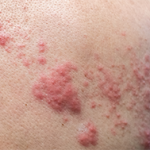The therapy has previously been found to be safe in the long term, but new technology—MRI, dual X-ray absorptiometry (DXA) and ultrasound—“offers [the] potential to scrutinize more carefully [the] structural effects of interventions,” said Timothy McAlindon, MD, MPH, chief of rheumatology at Tufts University.4
Intra-articular triamcinolone 40 mg every three months over two years into knees with synovitis has no major effect on structural measures either deleterious or beneficial. —Dr. McAlindon
Researchers randomized 140 knee OA patients—70 in each group—to receive injections of 40 mg of triamcinolone or saline every three months. Patients had to be at least 45 years old, with chronic knee pain and a WOMAC LK 3.1 pain subscore of at least 2.
Patients’ symptoms and self-reported function were assessed at each visit, with objective physical function tests given every six months. MRI and DXA imaging were done at 12 months and 24 months.
Researchers did find some difference in the cartilage damage index (CDI), with a drop in CDI of 0.84% in the saline group and a drop of 2.86% in the triamcinolone group. There was a drop in mean cartilage thickness of 0.57% in the saline group and of 1.7% in the triamcinolone group.

Dr. McAlindon
Dr. McAlindon noted that the difference, although significant in statistical terms, was not large.
“The relative differences are quite similar—about 1% difference in change between the two groups,” he said.
There were no statistical differences in the secondary outcomes of denudation, bone mineral loss, effusion volume and bone volume fraction.
“Intra-articular triamcinolone 40 mg every three months over two years into knees with synovitis has no major effect on structural measures either deleterious or beneficial. In particular, we found no evidence of accelerated progression,” Dr. McAlindon said. “Also, we found no influence on patient-reported outcomes or objective physical function tests over the long term.”
Thomas R. Collins is a medical writer based in Florida.
Second Chance
If you missed this session, it’s not too late. Catch it on SessionSelect
http://acrannualmeeting.org/resources/sessionselect
References
- Calabrese L, Xie F, Yun H, et al. Herpes zoster and the short term risk for ischemic stroke in patients with autoimmune diseases. Presented at the 2015 American College of Rheumatology/Association of Rheumatology Health Professionals Annual Meeting. Nov. 6–11, 2015. Abstract 896.
- Driban J, Lavalley M, Price L, et al. Intra-articular corticosteroids are safe and have no major effect on structural progression of synovitic knee OA: A 2-year randomized controlled trial of 3-monthly triamcinolone hexacetonide. Presented at the 2015 American College of Rheumatology/Association of Rheumatology Health Professionals Annual Meeting. Nov. 6–11, 2015. Abstract 897.
- Lin HC, Chien CW, Ho JD, et al. Herpes zoster ophthalmicus and the risk of stroke: A population-based follow-up study. Neurology. 2010 Mar 9;74(10):792–797.
- Raynauld JP, Buckland-Wright C, Ward R, et al. Safety and efficacy of long-term intraarticular steroid injections in osteoarthritis of the knee: A randomized, double-blind, placebo-controlled trial. Arthritis Rheum. 2003 Feb;48(2):370–377.
